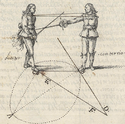|
|
You are not currently logged in. Are you accessing the unsecure (http) portal? Click here to switch to the secure portal. |
Difference between revisions of "Pedro de la Torre"
(Created page with "{{Infobox writer | name = name::Pedro de la Torre | image = | imagesize = | caption = | pseudonym =...") |
|||
| (2 intermediate revisions by the same user not shown) | |||
| Line 45: | Line 45: | ||
== Treatises == | == Treatises == | ||
| − | Though Pedro de la Torre's treatise is lost, Tim Rivera has created a [http://spanishsword.org/files/references.delatorre.pdf partial reconstruction] of it based on excerpts by later authors. He offers the following speculative description: | + | Though Pedro de la Torre's treatise is lost, [[translator::Tim Rivera]] has created a [http://spanishsword.org/files/references.delatorre.pdf partial reconstruction] of it based on excerpts by later authors. He offers the following speculative description: |
<blockquote>This work is at least 124 folios long, and is separated into at least two parts. Folio 58 is cited as being in chapter three, so it is likely that the second part starts before then. The treatise covers sword alone, dagger alone, sword and shield, montante, sword and cloak, two swords, sword and dagger, and sword alone against spear. Sword alone is likely the principal weapon, as it is called the queen of weapons. The two-sword method was created by the author. There are four principal guards: one at each shoulder and hip.</blockquote> | <blockquote>This work is at least 124 folios long, and is separated into at least two parts. Folio 58 is cited as being in chapter three, so it is likely that the second part starts before then. The treatise covers sword alone, dagger alone, sword and shield, montante, sword and cloak, two swords, sword and dagger, and sword alone against spear. Sword alone is likely the principal weapon, as it is called the queen of weapons. The two-sword method was created by the author. There are four principal guards: one at each shoulder and hip.</blockquote> | ||
| Line 51: | Line 51: | ||
== Additional Resources == | == Additional Resources == | ||
| − | + | {{bibliography}} | |
== References == | == References == | ||
| Line 58: | Line 58: | ||
{{DEFAULTSORT:Torre, Pedro de la}} | {{DEFAULTSORT:Torre, Pedro de la}} | ||
__FORCETOC__ | __FORCETOC__ | ||
| + | {{early Iberian masters}} | ||
[[Category:Masters]] | [[Category:Masters]] | ||
Latest revision as of 05:11, 7 November 2023
| Pedro de la Torre | |
|---|---|
| Born | date of birth unknown |
| Died | after 1474 |
| Occupation | Fencing master |
| Nationality | Spanish |
| Movement | Esgrima común |
| Genres | Fencing manual |
| Language | Spanish (?) |
| Notable work(s) | Lost treatise |
Pedro de la Torre (Petrus de Turri) was a 15th century Spanish fencing master. In ca. 1474, he is believed to have written a treatise on fencing with various weapons, including the side sword, both alone and with secondary weapons (cloak, shield, dagger, and double side swords), the dagger, and the montante. This treatise is described as being "published", though given the date it seems likely that it was a manuscript rather than a book. Unfortunately, no extant copies of Torre's work are known to exist, but there are several excerpts of it in later works on Iberian fencing, as well as those of his contemporary, Jaime Pons, and the later Francisco Román.
Treatises
Though Pedro de la Torre's treatise is lost, Tim Rivera has created a partial reconstruction of it based on excerpts by later authors. He offers the following speculative description:
This work is at least 124 folios long, and is separated into at least two parts. Folio 58 is cited as being in chapter three, so it is likely that the second part starts before then. The treatise covers sword alone, dagger alone, sword and shield, montante, sword and cloak, two swords, sword and dagger, and sword alone against spear. Sword alone is likely the principal weapon, as it is called the queen of weapons. The two-sword method was created by the author. There are four principal guards: one at each shoulder and hip.
Additional Resources
The following is a list of publications containing scans, transcriptions, and translations relevant to this article, as well as published peer-reviewed research.
- None.
References
|
|||||||||||||||||||||||||||

